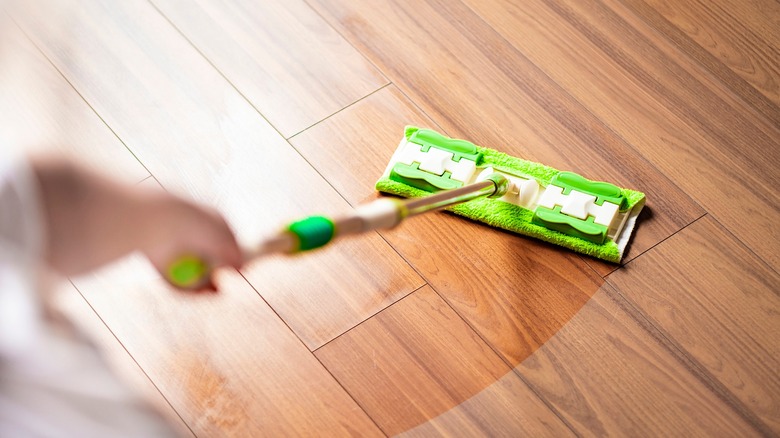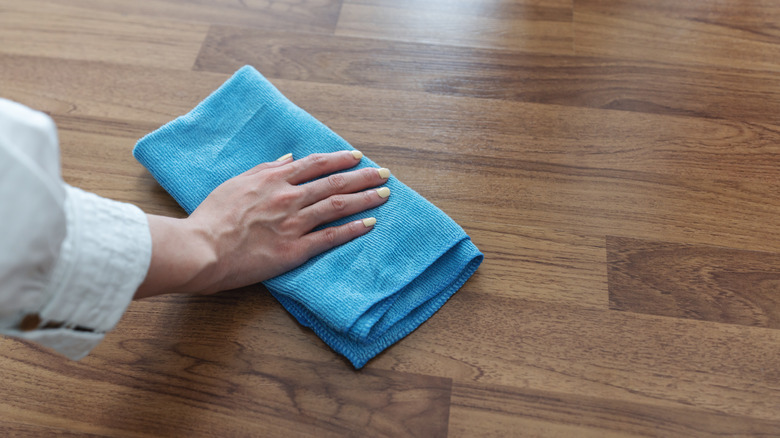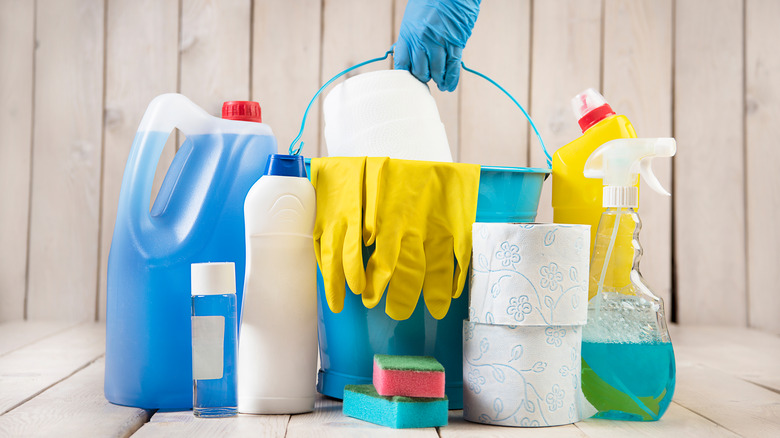What To Do If You Spill Bleach On Your Hardwood Floors
If you've accidentally (or even intentionally) spilled bleach on your hardwood floors, you're looking at a nuanced restoration process that demands immediate attention to the affected floorboards. You'll first need to clean the bleach off, and might also have to sand and restain the areas of the floor that the bleach didn't even touch. This is essential to keep everything looking consistent. Now, it's common knowledge that hardwood floors usually come with a protective finish like polyurethane, which is great for handling everyday wear and tear and defending against minor spills and scratches. But let's be clear: it's not a bulletproof shield. Strong and abrasive chemicals like bleach can rapidly degrade this protective layer, leaving the wood underneath susceptible to further damage.
Because wood is naturally porous, its cellular structure can act like a sponge, absorbing liquids if not treated quickly. This can cause many problems, from swelling and warping to outright buckling—issues that can be expensive to fix if left unchecked. So, you're not just dealing with a surface-level problem; you're wrestling with the integrity of the wood itself. The silver lining here is that all is not lost; you can mitigate damage with the right approach. If you're feeling overwhelmed about proper floor maintenance, take a breather; specialized cleaning solutions for hardwood floors are readily available. These products allow you to tailor your cleaning routine to your floor's unique needs and are much kinder to the wood over the long haul.
How to remove bleach from hardwood floors
To remove bleach from hardwood floors, first, grab a dry cloth and dab it on the spill. The goal is to soak up as much bleach as you can. Be careful not to rub it in too hard; doing so will only force the bleach deeper into the wood and worsen the damage. After blotting, lightly wipe the area with a wet cloth to neutralize and get rid of any leftover bleach. Finally, dry the area thoroughly and inspect the wood for any changes in color or texture. Even the smallest discoloration might indicate that the bleach has adversely affected the wood. If you note any major color changes or damage, it's best to consult a flooring specialist for further advice. They can guide you through specific treatments or procedures to effectively reverse or mask the damage.
Now, if you opt for a more robust restoration approach, sanding emerges as your go-to strategy. It's labor-intensive, but the quality of the end result typically justifies the effort. Sanding eliminates the damaged wood layer, restoring the area's color and texture. This rejuvenation almost magically returns your floor to its original state. If you're concerned about potential damage to adjacent areas during the sanding process, consider using an appropriate variety of painter's tape to isolate the affected spot. This helps you focus solely on the damaged area and prevents accidental scuffing or sanding of the surrounding wood, ensuring a more precise and effective restoration.
Milder alternatives for cleaning hardwood floors
If you intentionally poured bleach to remove a stain, it helps to know that bleach is not an ideal candidate for cleaning hardwood floors since its formulation is quite harsh. This potent oxidizing agent is generally composed of sodium hypochlorite or hydrogen peroxide. It's great for disinfecting and removing stubborn stains from various surfaces. However, hardwood floors are not among those surfaces. The problem lies in bleach's chemical structure, which can cause significant harm to the natural pigments and fibers in wood. This damage can result in a patchy, discolored appearance. Aesthetic concerns aside, bleach can also weaken the wood's structural integrity over time, making it less durable and more susceptible to wear and tear. Given these issues, it's clear that bleach is not the best choice for maintaining your hardwood floors.
Luckily, many gentler alternatives exist. If grease is your issue, you can simply clean your floors with hot water and soap. For disinfection, Clorox bleach-free wipes are another option. It's paramount to read labels when selecting cleaning products for hardwood floors. Always verify that the cleaner is hardwood-friendly to maintain the integrity and longevity of your flooring. Different types of hardwood may react differently to cleaning agents, so a small spot test in an inconspicuous area is often a smart precaution. The ultimate goal is not just cleaning but also preserving your hardwood flooring for the long term.


